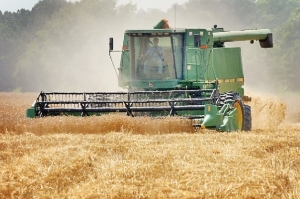Farmers: Wheat strong
By Dennis Hill
Published in News on June 3, 2009 1:46 PM

News-Argus/BOBBY WILLIAMS
Shawn Mitchell harvests a field of ripened winter wheat Monday off Arrington Bridge Road. Once the field is cleared, he plans to replant a second crop, probably soybeans. Mitchell said the wheat crop and its price per bushel are the best local farmers have seen in years. Agriculture officials said there are more than 20,000 acres of the golden grain in the county this year.
Wayne County farmers are expecting a good crop of winter wheat this year, with many of them already in the fields harvesting the golden grain.
Agricultural Extension agent Kevin Johnson said more than 20,000 acres of the crop were planted in the county this year. Statewide, there are about half a million acres of wheat ready for harvest.
"It's a good crop," Johnson said today. "We could be looking at 55 to 60 bushels per acre.
"There's going to be some wheat on sandy land where it got so hot back in May that won't do as well," he added, "but overall it's going to be an excellent wheat crop."
Relatively high prices for wheat and low prices for cotton convinced many growers to plant more grain and less cotton this year, Johnson said. Wheat has another advantage. It can be followed by soybeans to give a landowner a double crop. Most soybeans are planted directly following the wheat harvest, without tilling the land a second time.
Johnson said there will likely be less than 4,000 acres of cotton in the county this year, well below the 20,000 or so acres it has commanded for the past 15 years.
"The price is just so cheap," Johnson said. "There is so much cotton in the world. It's hard to make a profit. If you plant it, it's a gambling game."
Johnson said he expects to see a record number of acres of soybeans planted this year in Wayne County. A lot of fields that had been dedicated to cotton or corn will be planted in soybeans, he said.
Most crop fields in the county are in need of rain, he emphasized. Although some areas have received sufficient rain in recent weeks, most of it has been spotty, with one field getting water in a thunderstorm and another a half-mile away getting nothing.
He noted that the downpour that drenched the recent Relay for Life dropped only two-tenths of an inch of rain on a field only a short distance away.
"We need rain," Johnson said, adding that much of the corn crop is beginning to show the signs of lack of moisture. The corn will need rain in the next few weeks to make a decent crop, he said. The crucial time for rain is during the tasseling stage, when the plant makes its ears. That is usually late June or early July. Johnson said corn farmers are hoping for a few good days of steady rain between now and the end of the month.
Tobacco is doing well, he said. The leafy crop is less water dependent than corn. It is too early to tell how well the soybean crop is faring, he said, with only part of it in the ground.
Johnson said several Wayne farmers have planted another crop that is normally associated with the northeastern part of the state. There are about 1,500 acres of peanuts planted in the county this year.
"Over the past couple of years, it has moved into the county," Johnson said, noting that there are peanut fields in both the northern and southern areas of the county.
